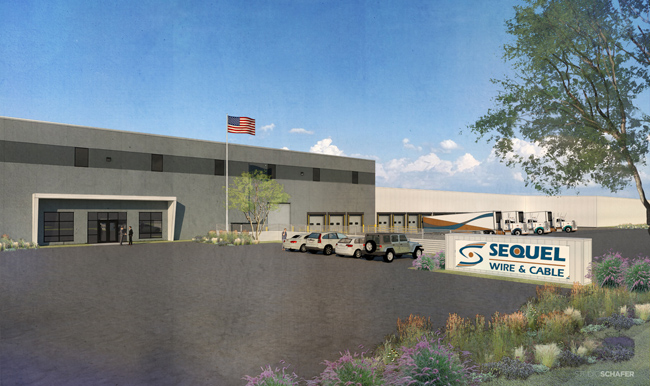Sequel Wire – A New Player with Deep Roots
by Joe Tito
Sequel
[ˈsēkwəl] noun. A work of literature, film, theatre, television or music that continues the story of, or expands upon, some earlier work.
If you’ve ever had the pleasure of working with a great team at some point in your life, you might dream about reassembling that team and creating a new and reimagined company. That’s exactly what Rich Carr did with a new wire and cable manufacturing company. It’s also why he chose the name Sequel.
A few weeks ago, I had the pleasure of speaking with Rich Carr and Denise Feece to discuss the creation of Sequel. They were excited about exhibiting at the EWPT Expo, and had an exciting story to tell about their launch. First, let’s cover Rich and Denise’s background. Their individual stories reveal a great deal about why they created Sequel Wire and Cable.
Rich has been in the Wire and cable business since 1973 when he began working for a company called Ristance. “We were originally a harness manufacturer to the appliance marketplace,” he recalled, “but grew to do a number of things.” The company began to make ignition wire sets, then became a PVC compounder with sights set on producing their own insulated wire. “We eventually fabricated our own copper and became fully vertically integrated,” he said. He served in many capacities, and eventually the company was sold to Echkin.
Rich stayed until 1990 when he and two other gentlemen started a wire company called Copperfield. “We operated Copperfield until 2007 when we sold it to Coleman,” Rich chronicled. “I stayed with Coleman until 2014 when that company was sold to Southwire.” Rich remained onboard for about three years. By that time, the company had migrated quite far from his original concept with Copperfield, so Rich decided to leave. As he served out his noncompete, he dreamed about recreating the magic he had with his team at Copperfield.
Denise then described her experience. “I started with Copperfield in 2005 and then transitioned to Coleman when the acquisition happened,” she remembered. “I worked out of the Coleman corporate office in Waukegan, IL, but when the Southwire acquisition occurred, I began to bounce around within the organization, doing a lot of traveling.” She decided the traveling was too much, and left Southwire in 2015. Denise worked for a couple of manufacturing concerns but never lost sight of those happy days at Copperfield. She constantly thought about being part of a similar business from an ownership position.
Having made the decision to create a new company with Copperfield as a model, Rich began to assemble the ownership team. In addition to Denise, with strengths in the operational and financial areas, he rounded out the ownership team with financial guidance from Jim Merritt, the former CFO of Copperfield, and Greg Miller, a seasoned business person with specialties in the insurance and benefits area. The facility will be managed by Andy Carr, Rich’s son. Andy boasts over 20 years of plant management experience with Copperfield/Coleman/Southwire. Sequel will be Andy’s third greenfield start-up in his career.
In order to grasp what Rich and his team aim to achieve with Sequel, it’s important to understand the niche they carved out at Copperfield, and why the formula worked so well. “Copperfield was a primary wire supplier to the OEM and distribution market,” he described. “It was mostly single conductor in the 26 to 4/0 AWG, with various insulation types; mostly PVC and crosslink polyethylene wire.”
It was this schematic, along with Copperfield’s unique commitment to customer service and special requests, that made them so attractive to Coleman, and eventually Southwire. “It’s a difficult footprint to operate in,” Rich outlined, “because even though the wire that the customer buys is very similar, each one wants them packaged a little differently, or has other special requirements.” He further explained that the OEM customer tends to be more demanding than other consumers of wire. “Most companies lack the capacity to put the programs together to give those customers the exact products they want at the right price, and with excellent quality and customer service.” This, Rich indicated, was Copperfield’s true calling.
From our conversation, it seemed reasonable that, although quality remained high, some of the attention to these niche needs waned as the company passed through subsequent owners. It’s that perceived void that propelled Rich and his crew to pursue that level of excellence once again. “That’s why we called our company Sequel,” he explained. “We think we can do the same thing over again. The market is ready for a good, sustainable supplier that will focus on their needs and give them the quality and service they desire and frankly, came to expect.”
“When I started Copperfield, I had a dream that a wire company could actually be different about the way they treated customers and employees.” Rich beamed. He aspires to what he calls the ‘two kings philosophy’, and plans to do the same at Sequel. “I believe you can treat your customers like kings and your production employees like kings, and so we will run the company with a servant mentality.”
But Sequel is not just a clone of Copperfield, as Rich revealed. “I don’t want to reproduce Copperfield, I want to build an even better version with Sequel.” Rich and his team are technologically savvy enough to realize that today’s manufacturing customer expects a high level of information that is fresh and readily available. “If they want to place an order or get an update at two o’clock in the morning, they can do that,” he informed. “People operate 24/7 these days, and they use their phones for everything, so our systems and culture will be very much aligned with that. If they would rather have human interaction, they’re able to do that as well,” he explained.
In deciding where to open up shop, the group was looking for the right community, with the right incentives, to start this business. Since they would be a big power user, electricity costs were crucial. They spent a great deal of time interviewing communities and settled on Argos Indiana. “It’s a very small community, about 1,500 people, and there’s not much industry, so we’re definitely the talk of the town,” Rich mentioned. The town of Argos had purchased some farmland and developed a new industrial park. Sequel will be the first tenant.
Sequel is in the process of making wire, and is in the final approval stage. They had a booth secured at the EWPT Expo, and were poised to be ready to take orders at that time. Although the show won’t happen in May, they are well on track to reach that goal. You can hear the excitement in their voices as they embark on this new venture, and they seem well poised for success. If you’d like more information on Sequel Wire and Cable, check out their website at www.sequelwire.com, or contact them at [email protected] 574-626-1515

































































